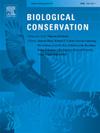海洋监测:基于陆地的公民科学观察表明,AIS数据不足以代表与海洋哺乳动物共同发生的沿海船只交通
IF 4.4
1区 环境科学与生态学
Q1 BIODIVERSITY CONSERVATION
引用次数: 0
摘要
海洋哺乳动物容易受到来自船只的各种影响,包括水下噪音干扰和碰撞伤害。为了量化这种风险,AIS(自动识别系统)船舶跟踪数据通常被用作船舶存在的代理。然而,许多船只没有出现在AIS数据集中,这意味着单独使用AIS来评估影响可能会低估影响发生的可能性。为了了解被低估的程度和与海洋哺乳动物同时发生的船只类型,为期3年的陆地调查记录了与鲸鱼、海豚和海豹同时观察到的所有船只(在距离海岸约10公里的范围内发现)(在距离海岸约3公里的范围内发现)。调查在五个苏格兰海洋区域的多个地点进行。观察到的反应血管也记录机会。在30%的调查期间,AIS数据准确反映了与海洋哺乳动物共同发生的沿海船只交通。所观察到的59%的船只没有广播AIS系统,AIS传播率存在季节性和空间差异,夏季AIS传播率最低(同期38%的船只广播AIS系统)。非ais船只更频繁地以可能对海洋哺乳动物构成更高风险的速度行驶,并且也更频繁地记录以引起反应。45%的回复涉及非ais动力船只,33%涉及人力动力船只(如皮划艇)。结果表明,与海洋哺乳动物共同发生的大多数船只都是非AIS,因此AIS数据本身不足以代表与船只相关的影响。本文章由计算机程序翻译,如有差异,请以英文原文为准。

Marine monitors: Land-based citizen science observations show AIS data underrepresents coastal vessel traffic co-occurring with marine mammals
Marine mammals are vulnerable to a variety of impacts from vessels, including underwater noise disturbance and injury from collision. To quantify this risk, AIS (Automatic Identification System) vessel tracking data is often used as a proxy of vessel presence. However, many vessels do not appear within AIS datasets, meaning evaluating impacts using AIS alone will likely underestimate the potential for effects to occur. To understand the scale of underestimation and the types of vessels co-occurring with marine mammals, 3-yrs of land-based surveys recorded all vessels (sighted within ∼10 km of shore) that were observed concurrently with whales, dolphins and seals (sighted within ∼3 km of shore). Surveys were conducted from multiple sites within five Scottish Marine Regions. Observations of responses to vessels were also recorded opportunistically.
AIS data accurately reflected coastal vessel traffic co-occurring with marine mammals during 30 % of the surveyed period. 59 % of vessels seen were not broadcasting AIS, with seasonal and spatial variation in AIS transmission rates, with lowest AIS transmission rates in summer (when 38 % of co-occurring vessels were broadcasting AIS). Non-AIS vessels were more frequently observed travelling at speeds that may pose an elevated risk to marine mammals, and were also more frequently recorded to elicit a response. 45 % of responses to vessels involved non-AIS powered vessels, and 33 % were in relation to human-powered vessels (e.g. kayaks). The results show that the majority of vessels that co-occur with marine mammals are non-AIS, and as such AIS data alone is insufficient to represent vessel-related impacts.
求助全文
通过发布文献求助,成功后即可免费获取论文全文。
去求助
来源期刊

Biological Conservation
环境科学-环境科学
CiteScore
10.20
自引率
3.40%
发文量
295
审稿时长
61 days
期刊介绍:
Biological Conservation is an international leading journal in the discipline of conservation biology. The journal publishes articles spanning a diverse range of fields that contribute to the biological, sociological, and economic dimensions of conservation and natural resource management. The primary aim of Biological Conservation is the publication of high-quality papers that advance the science and practice of conservation, or which demonstrate the application of conservation principles for natural resource management and policy. Therefore it will be of interest to a broad international readership.
 求助内容:
求助内容: 应助结果提醒方式:
应助结果提醒方式:


